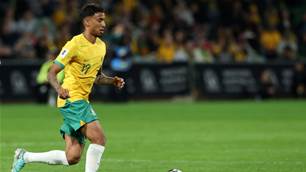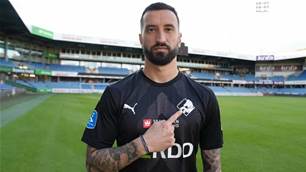WITH modern football moving more to a one-man striker system, Socceroo Josh Kennedy has the weight of a nation on his shoulders come South Africa in June.
Football evolves. From black and white photos harking back to the days of three defenders and five strikers, right through to the inspiration for the title of this magazine, the way the game is played is constantly changing. Never is this more apparent than when looking at the role of the man up front.
Being a striker has always been a vital position, as you need goals to win games. It is a big responsibility for the front men to ensure they do just that, but the role is now a more complicated and diverse one than it has ever been before.
The solo striker, or modern frontman, finds himself heavily outnumbered with minimal support.
"The modern forward is far more than a goalscorer," notes Jonathan Wilson in his book Inverting The Pyramid - The History Of Football Tactics. "Goals are obviously part of it, but the truly great modern forwards appear rather as a hybrid of the old strike partnerships. The likes of Didier Drogba and Emmanuel Adebayor are both target-men and quick-men, battering-rams and goalscorers, imposing physically and yet also capable of finesses."
Socceroos coach PimVerbeek has been lambasted for using his 4-2-3-1 system with many fans bemoaning a negative approach and branding the formation defensive. But the solo striker system can still work and produce a number of goals, providing the obvious need to have the right players for the positions.
With Kewell, Cahill, Bresciano and Emerton all vying for a role in the attacking midfield three, the shoice of the man up front has never been so important. Step forward Josh Kennedy.
The importance of Kennedy in South Africa, providing he is selected ahead of Kewell for the role, should not be over-estimated. Without Kennedy stepping up and playing out his skin, the Socceroos will face an uphill struggle.
"If I don't score goals, we always have Timmy Cahill, so we'll be alright," says Kennedy, half tongue-in-cheek, half concious of the obvious reliance the Socceroos have on the free-scoring Everton midfielder.
"There is always pressure and being the one-man upfront is no different. You are the last man up there, so if you get the ball you have to keep it and wait for support. You can take a lot of pressure off the team if you can hold up the ball. However the solo striker role depends a lot on who you have around you.
"With the formation Pim uses you always have an extra man in midfield and players who love to get up and down and put ball in the box. That's my bread and butter and it's my job to stick the ball in the back of the net. To make the system work you need players in the right positions and we have that in the Socceroos."
As for Kennedy falling into the lofty ranks of those considered a ‘modern striker' today?
"I bloody hope so," says Kennedy. "When you look at other players in that mould, like Rooney and Torres, they are different strikers to me. I'm lankier and like to hold up the ball more than those guys. There are a few different types of modern strikers and I see myself as one."
Pim's 4-2-3-1 formation has not only been knocked for it defensive look on paper, it has also been criticised for its aesthetical appearance in action too.
We're of course referring to an approach to playing the game which dates back to the origins of the game, but in recent years has become the buzzword for ugly football - using the long-ball.
While many fans, and local pundits, seem to think everyone should play like the freakishly talented all-conquering Barcelona side, reality is more pragmatic for most clubs and nations. The Socceroos are no exception.
"Everyone should play to their strengths," insists Kennedy. "So when you have me and Timmy Cahill on the pitch, we can get on the end of balls sent into the box.
"Obviously you don't want to be just hitting long balls in from the half-way line, but if you can get the ball into the box from more attacking positions, then in me and Timmy you have two players who are fantastic in the air so there is no reason not to play to those strengths."
It feels at times that the Socceroos' hands are slightly tied in terms of their approach to games - Kennedy leads the line alone because a partner, or ideal foil, is not an option.
Subscribers to that theory point to two frustrating Socceroos strikers - one who frustrates through an unwillingness to play, the other who struggles to score in the green and gold.The former being the retired Mark Viduka, the latter an out-of-sorts Scott McDonald who simply doesn't fit into Pim's solo striker system.
The credentials needed to successfully play the solo striker role - strong, with aerial ability, able to hold the ball up and finish - is not something Socceroos fans are alien to seeing from a Green and Gold forward in recent memory.
Mark Viduka was arguably the greatest striker in that mould Australia has ever produced. Talk of his return to the national team seemed an endless saga, even when he admitted his plans stretched no further than sitting on a yacht in Croatia somewhere.
Talk of a Viduka return has since faded out, but the hangover from the Dukes loss is still being felt in some quarters.
"I've had the question [about Viduka leaving] for some time now, ever since I've come into the Socceroos team and he was likely to retire at some point," says Kennedy. "He is a different type of player to me, he does things I can't do and vice-versa. There is always pressure when you play regardless of if Mark Viduka is available or not.
"Every team in the world could use a Mark Viduka, so no-one is pleased he's not going to be there and we'd welcome him back if he had turned around and said he could have made the World Cup."
While Dukes exile is self-inflicted, McDonald has been struggling domestically, now hoping a move to the Championship with Middlesbrough will help after falling out of favour at Celtic.
While goals against Milan and Manchester United in the Champions League prove McDonald can clearly play at the highest level, his form for Australia - 15 caps, no goals - means he is simply the square peg for the round hole reserved for the single Socceroos striker.
But surely Kennedy and McDonald are the quintessential old fashioned front two pairing, the tall one good in the air and the little one a natural goal poacher? Together they could be the Socceroos' answer to Spain's Torres and Villa or Barcelona's Ibrahimovic and Messi.
"Pim has chosen his formation to win games. We won our games and got to the World Cup so no-one can really complain. We do score goals and it is a formation that wins games.
"There is no reason why me and Scotty wouldn't work," admits Kennedy. "He has proved himself as a goalscorer and we probably complement each other quite well. When we played together for the Socceroos before we did okay, but Scotty has always been under a little bit of pressure because he hasn't scored goals for Australia yet, where I have managed to in the past."
With six goals in the Green and Gold to date, Kennedy has proven himself on the international stage, while a move from Germany to Asia has yielded a rich vein of scoring form.
After moving to Japan to join Nagoya Grampus at the end of last year, Kennedy found his feet, and goalscoring touch, quickly - six goals in 15 league appearances, including a debut goal and a further hat-trick in the Emperor's Cup.
It was needed after spending the end of his career in Germany on the bench, as Karlsruher crashed out of the Bundesliga. In terms of life as a striker, the two very different leagues have provided vastly different challenges for the striker.
"In terms of scoring, it is a lot more free-flowing and attacking in Japan and you are guaranteed to have a few chances per game, but there were times in Germany where you wouldn't even get a shot on goal," says Kennedy.
Does being six-foot seven help in the J.League too? "Generally the players in Japan are small, but pretty much every team has a tall centre-back. In every game in Japan I've felt like I could score goals, which is a great feeling for a striker.
"The players can get away with a lot more than in Europe though, they kick, punch and scratch a lot more, so for me it is probably a harder game then when I was playing in Germany."
With domestic matters now more settled for Kennedy, the greatest challenge of any striker is just months away. The World Cup in South Africa will pit the finest strikers against the fiercest defenders. But how will our man fair in this massive test?
"This is a World Cup and no game is going to be easy. I haven't thought too much in depth about scoring at the World Cup. I still have plenty of games in Japan before the World Cup starts. That said, it is going to be a big test for me and where I stand and how I have developed as a player."
A big test for a big man, Kennedy has the toughest of roles in the toughest competition. But with great responsibility can come great reward, as Josh will find out if he fires Australia to glory.
Josh Kennedy wears Puma V1.10, available at Rebel Sport and sport specialty stores nationally. For more information go to www.pumafootball.com
This article appeared in the April 2010 issue of FourFourTwo magazine. To buy back copies of this issue call 03-8317-8121 with a credit card to hand.
Related Articles

Socceroos midfielder embraces move to England

Cardiff City snap up sought-after Socceroos starlet













